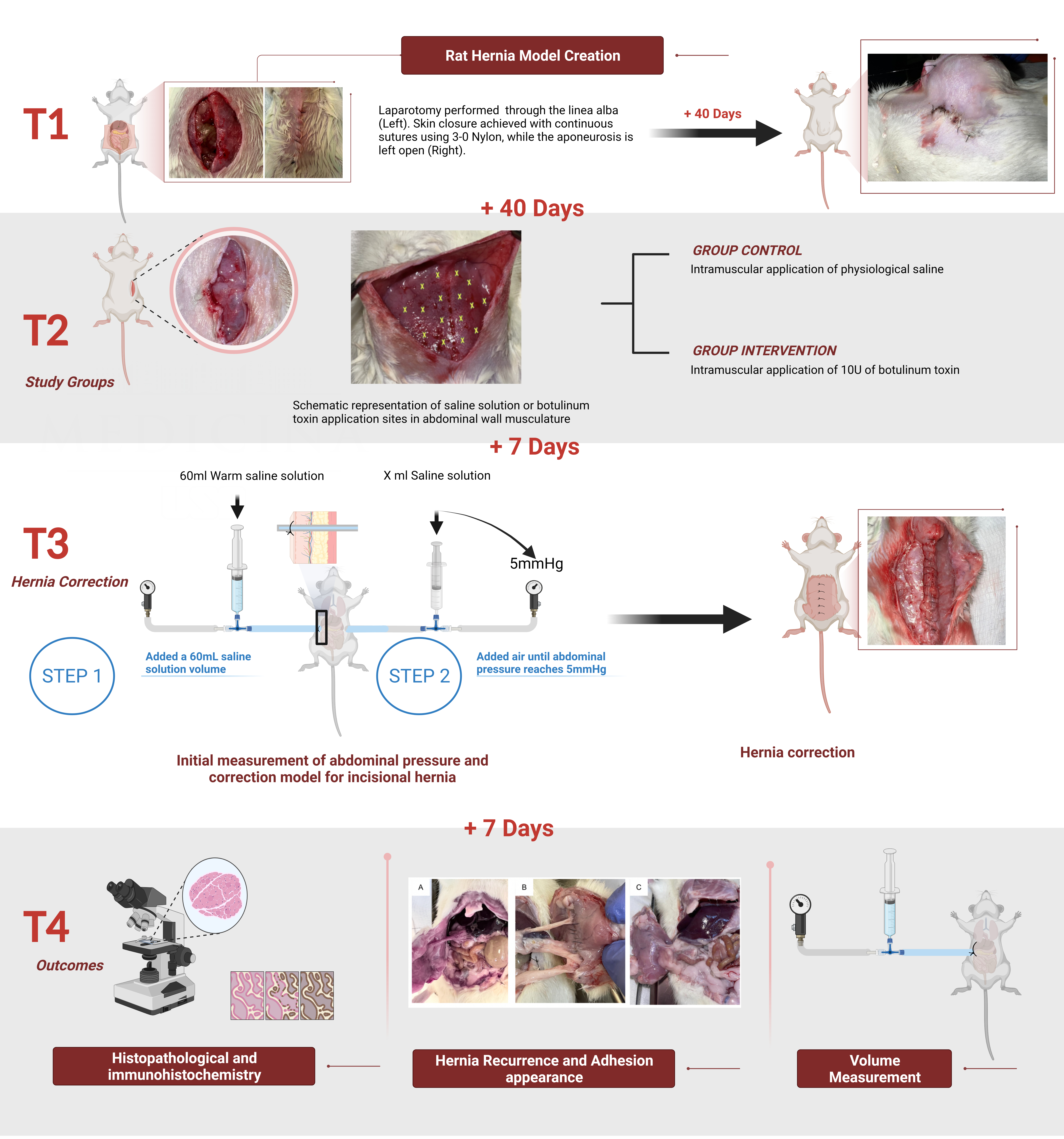Back to 2024 Abstracts
THE EFFECT OF PREOPERATIVE BOTULINUM TOXIN TYPE A IN AN INCISIONAL HERNIA ANIMAL MODEL
Eric T. Nakamura, Francisco Tustumi
*, Marina A. Pereira, Leonardo Cardili, Ana Paula Gárate, Bruno Cogliati, Cinthia Lanchotte, Sandra N. Sampietre, Ulysses Ribeiro, Venancio Avancini Ferreira Alves, Flávio Henrique F. Galvão
Universidade de Sao Paulo Faculdade de Medicina, Sao Paulo, São Paulo, Brazil
Introduction: The purpose of this study was to evaluate, in an animal model, the potential role of botulinum toxin type A (BTX) in preventing the recurrence of incisional hernia by inducing paralysis of abdominal muscles.
Methods: An incisional hernia model was created in 20 male Wistar rats by performing a laparotomy from the xiphoid bone to the penile base, closing the skin, and leaving the aponeurosis open. After 40 days, the rats were divided into two groups (1:1): In Group 1 (Control Group), the rats received saline solution in the abdominal wall musculature, and in Group 2 (Intervention Group), the rats received an application of 10 UI of BTX in the abdominal wall musculature. After 7 days, all animals underwent hernia repair and intrabdominal volume measuring. Finally, after 7 days, all rats were euthanized, and the outcomes were assessed. The outcomes evaluated were hernia recurrence, intrabdominal volume for a 5 mmHg pressure, macroscopic appearance, and histological analysis. Fisher exact test and Mann–Whitney U test were used for comparisons.
Results: The recurrence rate was strikingly higher in Group 1 than in Group 2 (90%
vs. 20%; p=0.005). The average defect size of Group 2 was smaller than Group 1 (2.2 ± 9.3 mm
vs. 9.3 ± 2.9 mm; p=0.008). The variation of intrabdominal volume after hernia repair was higher in Group 1 than in Group 2 (41 mL
vs. 18 mL, p=0.015). Regarding histopathological analysis, Group 1 exhibited more pronounced muscular fibrosis than the intervention group (p=0.016). In the control group, 80% of the rats displayed moderate to severe rhabdomyolysis, while only 20% in the intervention group showed signs of active muscle degeneration (p=0.007). No statistically significant differences were found between the groups in terms of the presence of seroma, spacing between muscle fibers, bacterial infection, serosal fibrosis, adhesion to the serosa, hypertrophic scarring, hematoma, cutaneous ulcer, muscle regeneration, visceral adhesion to the serosa, visceral adhesion to the skin, and macroscopic appearance of adhesion.
Conclusion: Preoperative application of BTX reduces the recurrence rate and the size of incisional hernias by changing the intrabdominal volume/pressure ratio and reducing the muscular fibrosis formation and rhabdomyolysis. Therefore, BTX emerges as a promising approach to preventing large incisional hernias.
 Figure 1.
Figure 1. This study methodology was divided into four periods (T1-4). In T1, an incisional hernia model was created in male Wistar rats by performing a laparotomy from the xiphoid bone to the penile base, closing the skin, and leaving the aponeurosis open. In T2, after 40 days, the rats were divided into two groups (1:1): Group 1 (Control Group), the rats received saline solution in the abdominal wall musculature, and Group 2 (Intervention Group), the rats received an application of 10 UI of BTX in the abdominal wall musculature. In T3, after 7 days, all animals underwent hernia repair and intrabdominal volume measuring. Finally, in T4, after 7 days, all rats were euthanized, and the outcomes were assessed. The outcomes evaluated were hernia recurrence, intrabdominal volume for a 5 mmHg pressure, macroscopic appearance, and histological analysis.
 Figure 2.
Figure 2. This table shows the comparisons between the control and intervention groups. Applying botulinum toxin before hernia repair was associated with a significantly lower risk for recurrence and smaller recurrent hernias. The intrabdominal volume change between the periods T4 and T3 was higher in the control group. In addition, botulinum toxin promoted less muscle fibrosis and rhabdomyolysis.
Back to 2024 Abstracts

